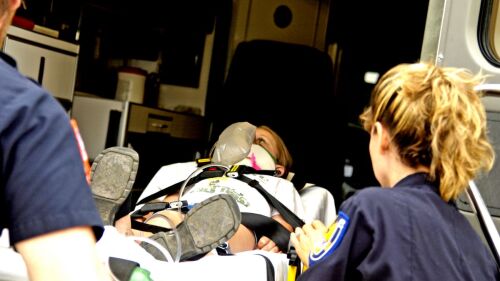BREAKING NEWS
After years of Christmas-season gaps, Carroll County maintained full staffing without mandatory overtime
Spirit EMS crews and community members collected and delivered more than 200 stuffed animals to hospitals and nursing homes across western Ohio and eastern Indiana
Austin-Travis County EMS drew 350 applications for its latest hiring cycle and graduated 17 cadets in December, while private providers and new grants aim to shore up EMT staffing
The new program places advanced EMTs and paramedics on scene in Willows to provide life-saving interventions before ambulances arrive
A Loveland fire code amendment taking effect in 2026 will mandate AEDs in new venues with occupancies of 100 or more
EXCLUSIVES
SPECIAL REPORTS
UPCOMING & ON-DEMAND EVENTS
Mission critical communications networks and Wireless WAN work in concert to enable first responders to make informed decisions and act quickly
How technological advances influence PSAPs and ECCs and redefine the public safety ecosystem
Join this discussion with real-life spouses Mike Taigman and Sascha Liebowitz, on how to repair burnout by reconnecting with loved ones and mitigating the impact of the job on your relationships.
Taking a deeper look into the role of technology in public safety, our presenters offer insights into current technology use, and how it can save lives.
Join us for a discussion of the 2021 EMS Trend Report’s findings and strategies to combat the major issues facing EMS
You wouldn’t make cookies with just a fraction of the ingredients, why would you make decisions without all the data?
Learn how mental health support programs can alleviate stress in the workplace
Relationships and trust are the foundation of partnerships and contracts
Find out the latest on how your agency can access ARP and other funding opportunities, as well as guidance around proposals, tactics and strategies
Data collected throughout the first half of the year help agencies and departments improve performance and service
Best practices for infection control before, during and after assessment, treatment and transport of 3 common EMS patient scenarios
Explore ongoing research into fatigue and strategies to both prevent and manage it
INDUSTRY INSIGHTS
Small changes to how EMS approaches airway management and ventilation can make big differences in OHCA outcomes
A webinar reviews key cases where the ‘most important vital sign’ helped shape care
Opioid-settlement dollars are already flowing to EMS – see how to use them to fund secure, compliant narcotics storage
It starts with sharpening decision-making skills
WATCH NOW
Reactive leadership won’t cut it. Discover how presilient EMS leaders build adaptive teams, reimagine risk, and turn uncertainty into opportunity.
OFF DUTY
Where to buy EMS pants that can stand up to the demands of the job
Five considerations for patient assessment, scene safety and patient handoff when responding off-duty
Laysha Ward teaches public safety leaders how to reframe life experiences into leadership superpowers, develop connection currency and align work-life goals for sustainable success
Explore top self-defense tools like TASERs, pepper spray and personal alarms. Learn how to choose, use, and store them safely and legally
Rapid decision-making and risk assessment skills make EMS professionals a perfect fit for high-paying safety leadership roles
EMS Products
Follow this expert guide to cleaning, conditioning and polishing your boots, belts and gear the right way
The benefits are numerous, but the startup can be daunting; become a meal-prepping pro with these top-rated solutions
Read the first five practical, no-nonsense strategies to help you stay sharp, resilient, and in control — no matter what the job throws at you
When intentions don’t match actions, trust and morale suffer. Learn how to lead with purpose, awareness and genuine presence
The habit? Working out with your dog in ways that support movement, recovery and routine
PRODUCT RESEARCH CATEGORIES
The EMS1 Radios product category features products and information for researching EMS radios, covering communications equipment, communications interoperability, wireless handsets and EMS radio-related equipment.
The EMS1 Communications Interoperability product category features products and information for researching Communications Interoperability solutions, including interfaces, P25 radios and other mobile and stationary technologies.
The EMS1 AEDs Automated External Defibrillators product category features information and product listings for researching AEDs, including defibrillators and data management solutions related to cardiac resuscitation..
The EMS1 Defibrillators and Monitors product category is a collection of information, product listings, and resources for researching Defibrillators and Monitors used by EMS personnel to aid in their assessment and treatment of patients.
The EMS1 Capnography product category features products and information for researching capnography’s use by EMS personnel to aid in their assessment and treatment of patients in the prehospital environment. Click here to download a guide to normal/abnormal capnography waveforms.
The Software product category features information, product listings and resources for researching EMS software solutions and covers a variety of software products such as billing, field data and scheduling software, as well as computer-aided dispatch (CAD) and electronic patient care reporting (ePCR).
The Financial, Insurance & Legal Services product category features information and resources for researching Financial Services solutions, as well as insurance options and legal resources, and includes financial leasing options, various types of insurance, mortgage tools and retirement planning assistance.
The EMS1 Driving Simulation product category features products and information for researching Driving Simulation software and training equipment.
The EMS1 EMS Body Armor product category features information, product listings and resources for researching body armor equipment and accessories for EMS.


















































